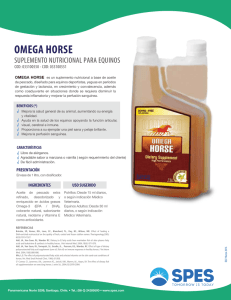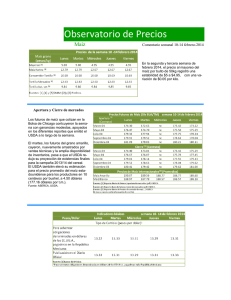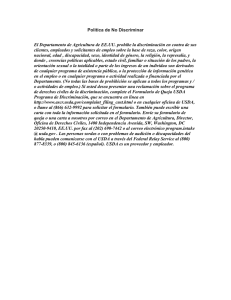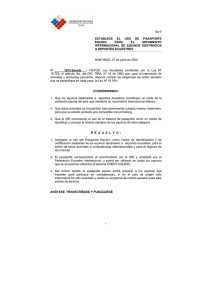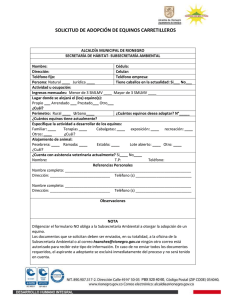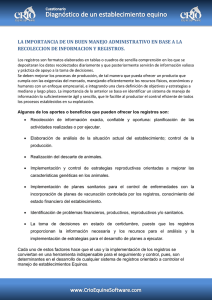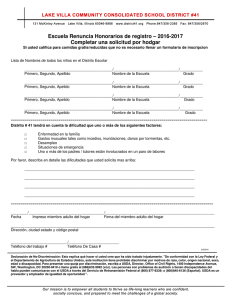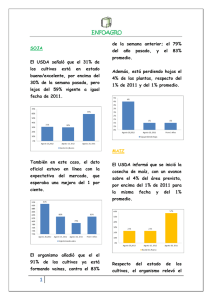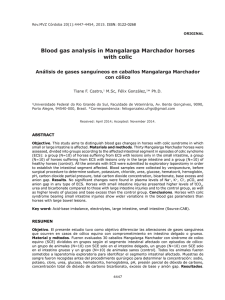Protect Your Horses from Equine Piroplasmosis ALWAYS NEVER
Anuncio
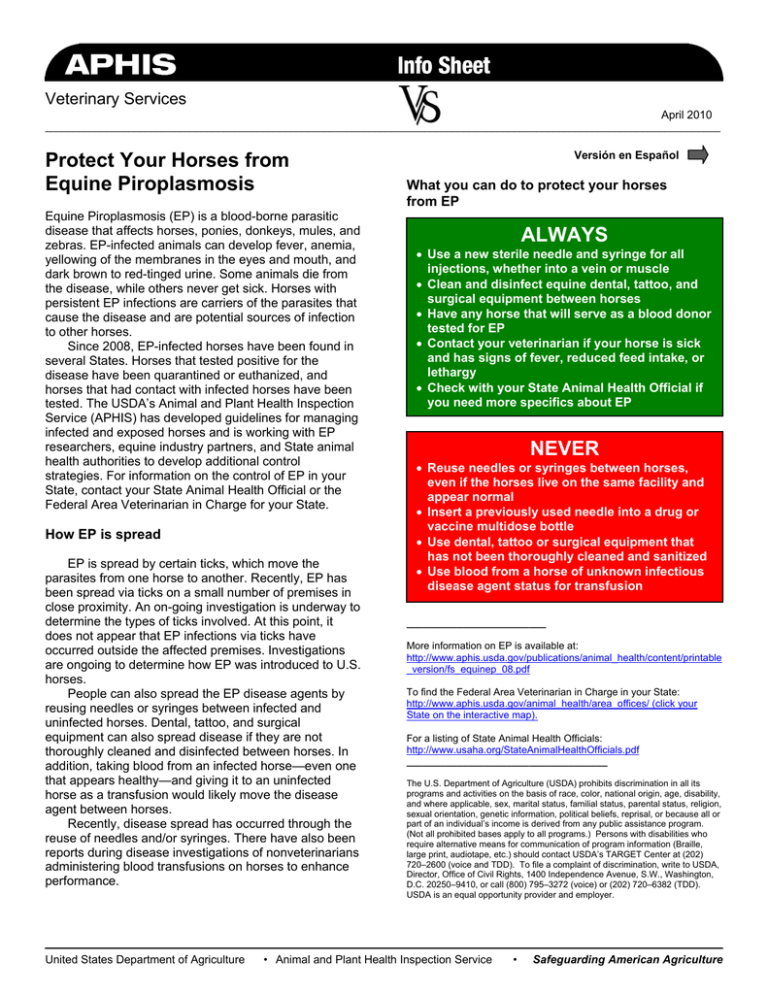
Veterinary Services April 2010 _________________________________________________________________________________________________________________________ Protect Your Horses from Equine Piroplasmosis Equine Piroplasmosis (EP) is a blood-borne parasitic disease that affects horses, ponies, donkeys, mules, and zebras. EP-infected animals can develop fever, anemia, yellowing of the membranes in the eyes and mouth, and dark brown to red-tinged urine. Some animals die from the disease, while others never get sick. Horses with persistent EP infections are carriers of the parasites that cause the disease and are potential sources of infection to other horses. Since 2008, EP-infected horses have been found in several States. Horses that tested positive for the disease have been quarantined or euthanized, and horses that had contact with infected horses have been tested. The USDA’s Animal and Plant Health Inspection Service (APHIS) has developed guidelines for managing infected and exposed horses and is working with EP researchers, equine industry partners, and State animal health authorities to develop additional control strategies. For information on the control of EP in your State, contact your State Animal Health Official or the Federal Area Veterinarian in Charge for your State. How EP is spread EP is spread by certain ticks, which move the parasites from one horse to another. Recently, EP has been spread via ticks on a small number of premises in close proximity. An on-going investigation is underway to determine the types of ticks involved. At this point, it does not appear that EP infections via ticks have occurred outside the affected premises. Investigations are ongoing to determine how EP was introduced to U.S. horses. People can also spread the EP disease agents by reusing needles or syringes between infected and uninfected horses. Dental, tattoo, and surgical equipment can also spread disease if they are not thoroughly cleaned and disinfected between horses. In addition, taking blood from an infected horse—even one that appears healthy—and giving it to an uninfected horse as a transfusion would likely move the disease agent between horses. Recently, disease spread has occurred through the reuse of needles and/or syringes. There have also been reports during disease investigations of nonveterinarians administering blood transfusions on horses to enhance performance. United States Department of Agriculture Versión en Español What you can do to protect your horses from EP ALWAYS Use a new sterile needle and syringe for all injections, whether into a vein or muscle Clean and disinfect equine dental, tattoo, and surgical equipment between horses Have any horse that will serve as a blood donor tested for EP Contact your veterinarian if your horse is sick and has signs of fever, reduced feed intake, or lethargy Check with your State Animal Health Official if you need more specifics about EP NEVER Reuse needles or syringes between horses, even if the horses live on the same facility and appear normal Insert a previously used needle into a drug or vaccine multidose bottle Use dental, tattoo or surgical equipment that has not been thoroughly cleaned and sanitized Use blood from a horse of unknown infectious disease agent status for transfusion _________________________ More information on EP is available at: http://www.aphis.usda.gov/publications/animal_health/content/printable _version/fs_equinep_08.pdf To find the Federal Area Veterinarian in Charge in your State: http://www.aphis.usda.gov/animal_health/area_offices/ (click your State on the interactive map). For a listing of State Animal Health Officials: http://www.usaha.org/StateAnimalHealthOfficials.pdf ____________________________________ The U.S. Department of Agriculture (USDA) prohibits discrimination in all its programs and activities on the basis of race, color, national origin, age, disability, and where applicable, sex, marital status, familial status, parental status, religion, sexual orientation, genetic information, political beliefs, reprisal, or because all or part of an individual’s income is derived from any public assistance program. (Not all prohibited bases apply to all programs.) Persons with disabilities who require alternative means for communication of program information (Braille, large print, audiotape, etc.) should contact USDA’s TARGET Center at (202) 720–2600 (voice and TDD). To file a complaint of discrimination, write to USDA, Director, Office of Civil Rights, 1400 Independence Avenue, S.W., Washington, D.C. 20250–9410, or call (800) 795–3272 (voice) or (202) 720–6382 (TDD). USDA is an equal opportunity provider and employer. • Animal and Plant Health Inspection Service • Safeguarding American Agriculture APHIS HOJA INFORMATIVA Servicios Veterinarios Abril 2010 _________________________________________________________________________________________________________________________ Proteja a sus Caballos de la Piroplasmosis Equina La Piroplasmosis Equina (PE) es una enfermedad parasitaria transmitida por la sangre que afecta a caballos, ponis, burros, mulas, y cebras. Los animales infectados con PE pueden presentar fiebre, anemia, membranas amarillentas en los ojos y la boca, y orina teñida desde café oscuro hasta rojo. Algunos animales mueren por esta enfermedad, mientras que otros nunca enferman. Los equinos con infecciones persistentes de PE son portadores de los parásitos que causan la enfermedad y son fuentes potenciales de infección para otros equinos. Desde 2008, se han encontrado equinos infectados con PE en varios estados. Los equinos positivos a la enfermedad han sido cuarentenados o sacrificados, y los equinos en contacto con equinos infectados han sido muestreados. El Servicio de Inspección de Animales y Plantas (APHIS por sus siglas en inglés) del Departamento de Agricultura de los Estados Unidos (USDA por sus siglas en inglés), ha desarrollado guías para el manejo de equinos infectados y expuestos, y está trabajando con investigadores de PE, socios de la industria equina y las autoridades estatales de salud animal, para desarrollar estrategias adicionales de control. Para información sobre el control de PE en su estado, contacte al Oficial Estatal de Salud Animal o al Veterinario de Area a Cargo del APHIS-Servicios Veterinarios. ¿Cómo se propaga la PE? Determinadas garrapatas extienden la PE, al movilizar los parásitos de un equino a otro. Recientemente, la EP se ha diseminado por la vía de las garrapatas a un pequeño número de predios que se encuentran cercanos. Se está llevando a cabo una investigación para determinar los tipos de garrapatas involucradas. En este punto, no parece que las infecciones de PE por garrapatas hayan ocurrido fuera de los predios afectados. Se están realizando investigaciones para determinar cómo fue introducida la PE a los equinos de los Estados Unidos. Las personas también pueden diseminar los agentes de la enfermedad cuando utilizan agujas o jeringas usadas entre equinos infectados y no infectados. El equipo para uso dental, de tatuaje y quirúrgico puede también propagar la enfermedad si no está completamente limpio y desinfectado. Además, hacer una transfusión de sangre de un equino infectado— aunque parezca sano—a un equino no infectado probablemente transmitiría el agente de la enfermedad entre los equinos. Recientemente, la diseminación de la enfermedad ha ocurrido por utilizar agujas y/o jeringas usadas. También se ha reportado durante las investigaciones de la enfermedad sobre personal no veterinario que administra transfusiones de sangre a equinos para mejorar su rendimiento. Departamento de Agricultura de los Estados Unidos ¿Qué puede hacer para proteger sus equinos de la PE? SIEMPRE Use agujas y jeringas nuevas esterilizadas para todas las inyecciones, sean en vena o músculo Limpie y desinfecte el equipo dental, de tatuaje y quirúrgico con cada equino Haga pruebas de PE a cualquier equino que sea donante de sangre Contacte a su veterinario si su equino está enfermo y tiene fiebre, letargo o reduce su ingesta de alimento Si necesita mayor información de la PE consulte a su Oficial Estatal de Salud Animal NUNCA Utilize agujas o jeringas usadas en otros equinos, aunque vivan en las mismas instalaciones y parezcan normales Inserte una aguja usada en frascos de dosis múltiple de vacuna o medicamento Use equipo dental, de tatuaje o quirúrgico que no se haya limpiado y desinfectado totalmente Use sangre para transfusión de un equino con estado desconocido del agente infeccioso _________________________ Más información sobre PE está disponible en: http://www.aphis.usda.gov/publications/animal_health/content/printable _version/fs_equinep_08.pdf Para encontrar al Veterinario Federal de Area a Cargo en su Estado: http://www.aphis.usda.gov/animal_health/area_offices/ (click en su Estado en el mapa interactivo). Para una lista del los Oficiales Estatales de Salud Animal: http://www.usaha.org/StateAnimalHealthOfficials.pdf ____________________________________ El Departamento de Agricultura de E.U. (USDA) prohíbe la discriminación en todos sus programas y actividades debido a raza, color, lugar de nacimiento, edad, discapacidad, y donde aplique, sexo, estado civil o familiar, religión, orientación sexual, información genética, preferencias políticas, represalias, o porque los ingresos de un individuo, total o parcialmente, provengan de algún programa de asistencia pública. (No todas las prohibiciones aplican a todos los programas.) Personas con discapacidades que requieran medios alternativos para comunicación de la información del programa (Braille, impresión grande, audiocintas, etc.) deben contactar al Centro TARGET del USDA al (202) 720–2600 (voz y equipo para sordos). Para presentar una queja por discriminación, escriba al USDA, Director, Oficina de Derechos Civiles, 1400 Independence Avenue, S.W., Washington, D.C. 20250–9410, o llame al (800) 795–3272 (voz) o al (202) 720–6382 (equipo para sordos). USDA apoya la igualdad de oportunidades. •Servicio de Inspección de Animales y Plantas • Salvaguardando la Agricultura Americana
